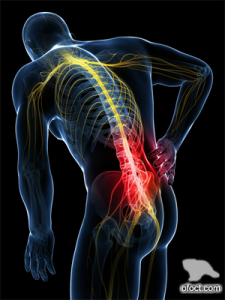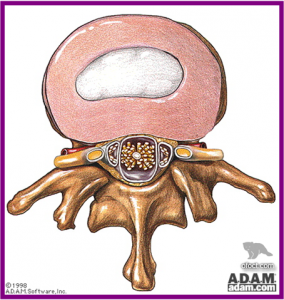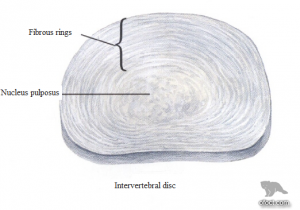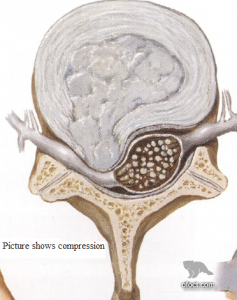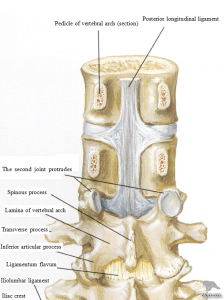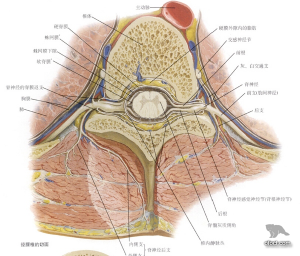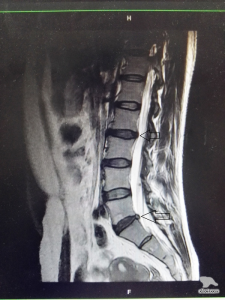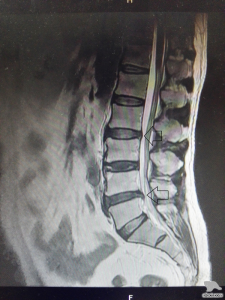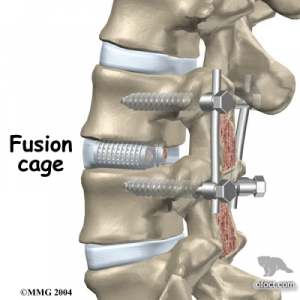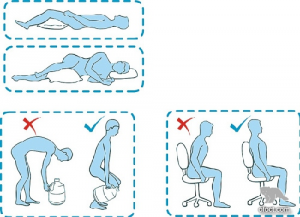Recently, many friends ask me about lumbar disc, I am an orthopedist and I just want to gossip about some stories that have to be said about lumbar disc herniation (LDH).
You don’t need to know why about common diseases, because doctors know enough. And you don’t need to know how about common diseases, because you only need to listen to doctors. But LDH is an unusual disease, I strongly recommend that you know about the past and present of the disease, because you really need to make your own decisions about the disease at many times.
When I was ignorant (that is, in sophomore and junior years), I was really blind to internal medicine, surgery, gynecology and pediatrics, but I had enthusiasm. There were two-stage mentors in school, that is, the hospital asked an attending doctor for serving as instructor of three-member group, then we would go to the affiliated hospital for watching happily after class. Remembering that the attending doctor who guided me was a spinal surgeon, there were so many patients with LDH. Then after I watched his special outpatient service for two or three times, I drew a conclusion that the treatment methods for LDH were to have an intravenous drip and operation. If there is no bed in the ward, outpatient clinic is asked for intravenous drip, and if there is bed in the ward, the patient will be accepted for operation. At that time, I was quite proud and told the discovery to my relatives and friends who asked me how about LDH, and advised them not to have an operation. Then a couple of years had passed.
Later, when seeking graduate study in a hospital known as orthopedics, I had another new discovery. At that time, our postgraduates were in the emergency department for help, while there was no emergency in spine surgery. Then we would usually advise LDH even lumbar vertebrae fracture patients those who suffered writhing pain to go to certain military hospital. For us medical students who learned extremities and joints orthopedics, spine surgery was such high-end. In my impression, to have an operation required 100000 at least at that time, doctors would do operations till midnight every day, and an operation required four or five hours, doctors who were 40 years old were not necessarily able to act as operator, and patients would paralyze accidentally if doctor’s hands trembling.
Therefore, if relatives and friends asked me, I would answer that to have intravenous drip was the first and then went to certain military hospital for operation if couldn’t suffer, because surgery trauma was quite large and risk was also too large, which scared a large number of people off.
Later, I moved out and transferred to base, sub-discipline was not divided so carefully. After watching several lengthy operations without knowing what the attending doctor was doing, I took pains to have a thorough understanding of the disease. Now my suggestion is if there is unbearable pain, numbness of lower limb or weakness in urination and defecation, it is suggested to have an operation for treatment.
Now let me introduce what is intervertebral disc
This is intervertebral disc, it belongs to organization without blood supply, once damaged, it can hardly self-healing. The part outside intervertebral disc is called fibrous rings and inside is called nucleus pulposus, nucleus pulposus belongs to one of the only two kinds of autoantigens (Another, guess what? It is semen) of human body, it will cause autoimmune response of body, which is inflammation. People with little medical knowledge all know, what is the performance of inflammation? Swelling and heat pain, dysfunction. Nucleus pulposus will not swell itself, it makes whatever encountered swell, so it often makes spinal cord or nerve root swell, and generates oppression, and spinal cord or nerve root makes you have unbearable pain if being hit by physical and chemical double blow. Therefore, the functions of the important drugs mannitol and dexamethasone for conservative treatment are dehydration, relief of swelling and suppression of immunoreaction.
In the above picture, the nucleus pulposus of intervertebral breaks through fibrous rings and compresses nerve root.
Then, do traction, medical massage, acupuncture and qigong have effect? Speaking of traction, I want to introduce a friend of intervertebral disc, posterior longitudinal ligament (see below). The small friend protects intervertebral disc from its extruding like plastic wrap (in fact, it is more reliable than plastic wrap), but protrusion of intervertebral disc makes it slack, and traction tightens it and pushes intervertebral disc back by lengthening the spine, but tightening of posterior longitudinal ligament will further lead to its relaxation, just like elongated plastic wrap is difficult to return to its original length, posterior longitudinal ligament will be looser and looser, and intervertebral disc will be more and more protruding, this is the reason why traction can suddenly make you very comfortable, but comfort will be less and less.
Seen from the picture, posterior longitudinal ligament is attached on the rear surface of vertebral body and intervertebral disk to prevent fracture blocks or nucleus pulposus entering into spinal canal when in fracture of lumbar vertebra or intervertebral disc protrusion.
In terms of medical massage, it pushes muscles in the waist and it has the best effect for lumbar muscle strain which is misdiagnosed as LDH, you can see the picture below, from the back to intervertebral disc, hypertrophic muscles of the back as well as spinous process and transverse process of the lumbar vertebrae have to be passed by, if someone claims that he can help you to push intervertebral disc back, the difficulty is not less than wrapping a layer of quilt outside a computer case, then you have to remove computer video card through massaging quilt, is it possible? It is probably very difficult, it is possible to do if combining with qigong.
From the back to intervertebral disc, hypertrophic muscles, spinous process, lamina of vertebral arch, pedicle of vertebral arch and vertebral hole have to be passed, therefore, medical massage of intervertebral disc is quite difficult.
Therefore, for clinician who has received more formal science education like me, I think the above methods are nothing. Then to return to the subject, under what circumstances to choose surgical treatment? What is the effect of surgical treatment? Is the operation risk big? Will be painful after done? Will be paralyzed if having an operation?
In the above picture, obvious protruding spinal canal can be seen in the intervertebral disc of waist 2 and waist 5, and compression generates.
Compare the intervertebral disc indicated by the arrow with other intervertebral discs, obvious differences can be seen.
When intervertebral disc protrudes and compresses spinal canal for more than 1/3 or numbness of lower limb, mobility problems, weakness in urination and defecation and other situations appear, surgical treatment (as above picture) can be considered. Surgical treatment is now a mature technology with reliable curative effect and controllable risk, compression will be relieved after done. At present, I haven’t seen people who have paraplegia after done, if paraplegia appears, it is probably a critical medical negligence. Surgical method is basically posterior decompression and fusion skill of internal fixation, simply speaking, it is to pull intervertebral disc out and implant the cage being filled with its bone in the vacant position, it is probably like this.
Then the two lumbar vertebras grow and fuse together, who will be afraid of protrusion without intervertebral disc? Funny….
Everything has two sides, what is the harm of surgical treatment?
The first is mobility loss of lumbar vertebrae. Restriction of interbody fusion on mobility is easy to understand. People have 7 cervical vertebras and 12 thoracic vertebras, 5 lumbar vertebras can mobilize, mobility loss of one or two vertebral bodies is not a particularly important thing, but if some people have protrusion of several segments of intervertebral discs, a three vertebral body and even four vertebral body fusion is very easy to cause the situation of being unable to bend down, but I think this is simply not a thing compared with patients with ankylosing spondylitis.
The second, which is also the most important to be noted, is the relapse of LDH. The fused segment will not relapse again, but the originally more average pressure distribution is conducted on the last section of intervertebral disc through nail-stick system, thus resulting in pressure increase and being more easily to lead to LDH. If the patient has LDH again several years after having an operation, it is undoubtedly very difficult to accept.
Actually, I think that it is the worst result if LDH reaches the degree of requiring surgical treatment, the most critical is to prevent causes of disease. In addition to uncontrollable genetic factors, to develop good living habits is of great significance.
What are good living habits? First of all, it is sitting posture. Because modern people sit for most time, therefore, sitting posture has great influence on intervertebral disc, especially forward sitting position, gravity forward makes pressure play a role of squeezing in intervertebral disc, reliable biomechanics report:
Pressure test of intervertebral disc
Standing position —-100%
Sitting position —-120%
Standing forward bend position —-210%
Sitting forward bend position —-270%
Therefore, bending forward position or weight-bearing is bad posture for causing lumbar spinal degeneration or injury.
Therefore, the first for protecting the intervertebral disc is to avoid weight-bearing. If you move bricks on the construction site, please refer to the upper left picture about \ posture, if you are a coding peasant, please learn the upper right picture to code words straight.
Of course, the most beneficial posture for lumbar vertebrae is sleep lying every day. Generally speaking, animals walking with four feet such as cats and dogs will not have LDH, while human beings walk upright, which applies too much pressure on lumbar vertebrae and then leads to LDH, therefore, weight loss can effectively alleviate the pressure of intervertebral disc and prevent LDH.
The authoritative book Campbell’s Operative Orthopedics of orthopedics also points out that the degree of education has negative correlation with the incidence of LDH, the more books read, the less engaged in heavy physical activities, and the healthier is intervertebral disc. And well-developed muscles in the waist and back can make waist keep straight state, and protect intervertebral disc, soldiers have considerable advantages in this point.
OK, coding so many words, I think I have said clearly about what I need to say, you can post to comments section if you still have problems.
(Author:云雀叫了 Source:zhihu.com, ofoct.com translate to English version)

